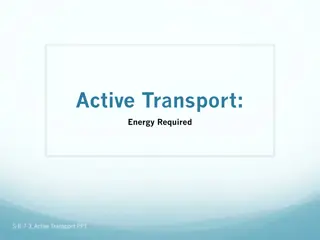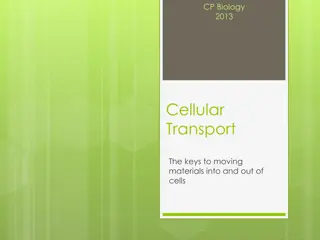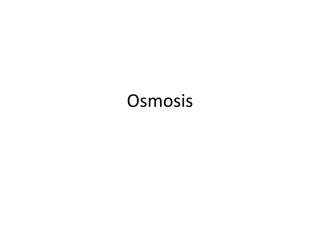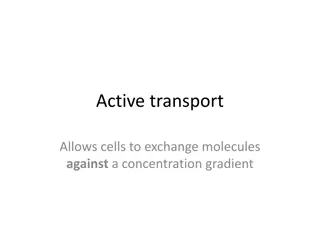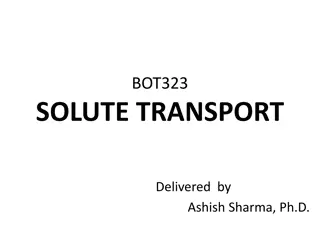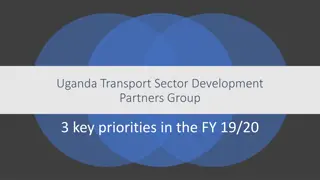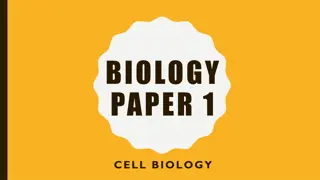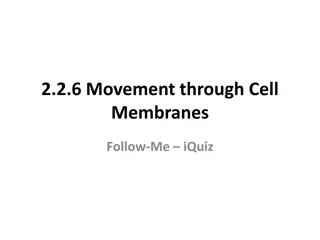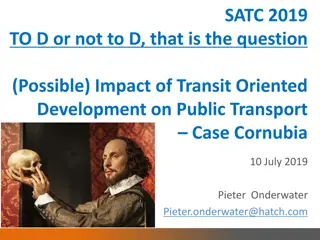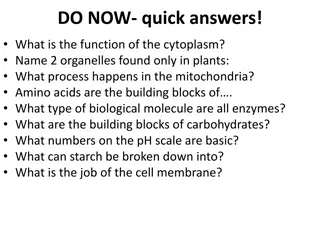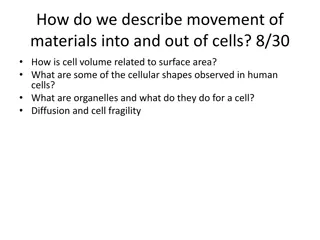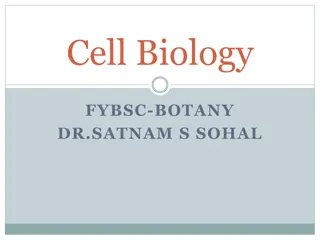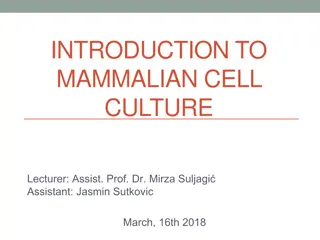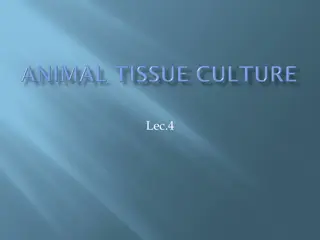Vi-CELL.BLU - Advanced Cell Counting Instrument
Vi-CELL.BLU is a cutting-edge cell counting instrument that offers faster analysis, increased resolution, and improved optical sensor technology for enhanced cell concentration and viability assessments. The device features a user-friendly interface, Trypan blue method for live cell detection, and a
1 views • 19 slides
Understanding Virus-Cell Interactions: Mechanisms and Consequences
Viruses interact with host cells in various ways, encoding genes that manipulate cell functions for their benefit. These interactions can range from benign to lethal outcomes. Factors influencing these interactions include viral factors, cellular responses, and the presence of virulence factors. Dif
0 views • 37 slides
Understanding Cell Reproduction and the Cell Cycle
Explore the process of cell reproduction, DNA structure, chromosomes, and the differences between prokaryotic and eukaryotic cell cycles. Learn about binary fission, mitosis, and cytokinesis in the context of cellular growth and division. Understand the significance of genes, DNA organization into c
5 views • 56 slides
Understanding Cell Viability Assays in Laboratory Testing
Cell viability assays play a crucial role in determining the health and status of cells, measuring their ability to survive and proliferate. These assays involve various techniques such as dye exclusion, colorimetric, fluorometric, luminometric, and flow cytometric assays. By assessing factors like
6 views • 16 slides
Understanding Active Transport: Energy-Driven Cellular Processes
Active transport is a vital process in cells that require energy in the form of ATP to move materials across the plasma membrane against their concentration gradient. This process involves pumps, endocytosis, and exocytosis. The sodium-potassium pump in nerve cells is a classic example of active tra
0 views • 9 slides
Understanding Cell Membrane Transport: Diffusion and Facilitated Diffusion
Cell membrane transport plays a crucial role in maintaining cellular functions by regulating the movement of substances across the membrane. Diffusion, a passive transport process, allows molecules to move from areas of high concentration to low concentration without energy expenditure. Within diffu
2 views • 20 slides
Understanding Passive and Active Transport in Cells
Explore the processes of diffusion, osmosis, and active transport in cells. Understand the similarities and differences between them, and learn why active transport is crucial for living organisms. Watch a video on active transport and answer related questions to deepen your knowledge. Enhance your
1 views • 12 slides
Bacterial Cell Structure and Composition Overview
Bacterial cells exhibit variations in size, typically ranging from 0.75 to 1.5 micrometers. The cell envelope, comprising glycocalyx, cell wall, and cell membrane, plays crucial roles in protection and cell function. The cell membrane, a thin barrier rich in phospholipids and proteins, is integral t
1 views • 28 slides
Understanding Cellular Transport and the Role of Cell Membrane
Explore the process of cellular transport, where materials are exchanged between organisms and their environments. Discover the types of materials transported into and out of cells, from water to waste materials. Delve into the significance of the cell membrane as the final point of transfer and its
0 views • 61 slides
Overview of Cell Culture Methods and Importance in Research
Introduction to the principles of cell culture, including tissue culture, organ culture, and cell culture methods. Discusses the advantages and disadvantages of each technique and highlights the need for cell culture in research for studying cellular behavior and large-scale production of cell mater
3 views • 45 slides
HyTrEc2: Advancing Hydrogen Transport Economy in the North Sea Region
HyTrEc2, a project under the Interreg VB North Sea Programme, aims to promote green transport and mobility by implementing innovative hydrogen transportation solutions. With a vision to stimulate hydrogen-fueled transport for a sustainable future, the project focuses on developing zero-emission solu
0 views • 23 slides
National Land Transport Amendment Bill 2018 Overview
The National Land Transport Amendment Bill of 2018 aims to address developments in the land transport system since 2009. It includes provisions for non-motorised and accessible transport, revises public transport contracting arrangements, clarifies government functions, streamlines operating license
0 views • 44 slides
Regulation of the Cell Cycle: A Comprehensive Overview
Variation in cell cycle length in humans, controlled by internal and external mechanisms, with special proteins and checkpoint systems ensuring proper progression. External events trigger initiation and inhibition of cell division, while internal checkpoints maintain genetic integrity and chromosome
4 views • 14 slides
Understanding Osmosis and Cell Membrane Transport
Osmosis is the process of water molecules diffusing across a semi-permeable membrane, crucial for maintaining cell function. It involves the movement of water from areas of high concentration to low concentration until equilibrium is reached. Special proteins called aquaporins facilitate water trans
1 views • 24 slides
Understanding Cell Transport and Homeostasis in Biology
Delve into the world of cell transport and homeostasis, exploring the functions of the cell membrane, the molecules involved, the fluid mosaic model, and passive transport mechanisms like diffusion, osmosis, and facilitated diffusion. Learn about the intricacies of maintaining equilibrium within cel
0 views • 10 slides
Key Notables in NLTA Amendment Bill for Integrated Transport Network
Presentation by Mr. R. Lungile Mabece at the 38th Southern Africa Transport Conference focusing on notable changes in the National Land Transport Act (NLTA) Amendment Bill and implications for implementing an Integrated Public Transport Network (IPTN). The presentation discusses key developments, im
0 views • 16 slides
Understanding the Cell Cycle and Mitosis Process
The cell cycle consists of two main periods: Interphase and Mitosis. During Interphase, the cell prepares for division by growing in size and copying chromosomes. Mitosis, the division of the nucleus, results in the formation of two daughter cells with identical chromosome copies. Centrioles and cen
0 views • 26 slides
Understanding Cell Division: Processes and Types
Cell division is a vital process in living cells for growth and reproduction. This article explores the basics of cell division, including the cell cycle, types of cell division (such as mitosis and meiosis), and the initiation of cell division. It also covers key phases like interphase and provides
0 views • 20 slides
Overview of Cell Division in Prokaryotes and Eukaryotic Cells
Cell division plays a crucial role in the growth and reproduction of all organisms. In prokaryotic cells, binary fission is the primary mode of division, while eukaryotic cells undergo a more complex process involving cell growth, DNA replication, chromosome distribution, and cytokinesis. The cell c
0 views • 10 slides
Understanding Active Transport in Cells
Active transport allows cells to move molecules against their concentration gradients by using energy and carrier proteins. This process requires ATP, involves carrier proteins acting as pumps, and is selective in the molecules it transports. The Na+/K+ATPase pump is a key example of active transpor
0 views • 44 slides
Understanding Ion Channels in Cell Communication
Ion channels play a crucial role in cell communication by allowing ions to pass through cell membranes, controlling various cellular functions. Their high transport rate and electrochemical gradient differentiate them from other ion transporter proteins. Ion channels have diverse biological roles, i
0 views • 26 slides
Comprehensive Overview of Transport Operations
Explore the various aspects of transport management including mechanisms for ensuring a smooth flow of goods, freight characteristics, criteria for selecting vehicles, lorry fleet management, ground transport capacities, and factors influencing transport decisions. Learn about managing lorry fleets,
0 views • 10 slides
Understanding Membrane Transport in Plant Cells
Plant cells rely on membrane transport to facilitate the movement of molecules across their plasma membrane. This process involves passive and active transport mechanisms, with the help of specialized proteins such as channels, carriers, and pumps. Channels serve as selective pores for ions and wate
0 views • 20 slides
Uganda Transport Sector Development Partners Group Priorities FY 19/20
This document outlines key priorities identified by the Uganda Transport Sector Development Partners Group for the fiscal year 2019/2020. The priorities include institutional framework optimization, legislative reforms, preparation of policy reports, and capacity-building initiatives within the tran
0 views • 6 slides
Explore the World of Developmental and Cell Biology
Developmental biology, stemming from embryology, investigates how organisms evolve from a zygote. It merges various fields like genetics, cell biology, and cancer biology. Cell biology focuses on cell properties and behaviors, using tools like genomics and microscopy. Research areas include cancer c
0 views • 8 slides
Cell Biology Overview and Organ Systems in Biology Paper 1
The Biology Paper 1 content covers topics such as cell specializations, cell division, organelles, enzyme functions, and organ systems including the cardiovascular system. It discusses key concepts like stem cells, mitosis, diffusion, osmosis, active transport, and various cell components such as nu
0 views • 8 slides
Understanding Osmosis in Cell Membranes
This quiz explores the concept of osmosis in cell membranes, focusing on the movement of water into outermost cells of roots by osmosis and its implications on cell sap. It covers topics such as active transport, diffusion, pressure in cell contents, and the role of water movement in maintaining the
0 views • 50 slides
Role of Cell Cycle in Nanoparticle Uptake and Dilution in Cell Population
The cell cycle plays a crucial role in the cellular uptake and dilution of nanoparticles within a cell population. This process involves different phases such as G1, S, G2, and M, each with specific functions related to cell growth, DNA synthesis, protein synthesis, and cell division. Understanding
0 views • 20 slides
Impact of Transit Oriented Development on Public Transport: Case Cornubia
Investigate the influence of Transit Oriented Development (TOD) factors on the public transport system, including improved public transport density, mixed-use design, and pedestrian-friendly infrastructure. This paper explores the theoretical application of TOD in urban planning with a focus on the
0 views • 16 slides
Cellular Processes and Functions Explained
The cytoplasm is essential for cell function, housing organelles like chloroplasts and vacuoles unique to plants. Mitochondria facilitate cellular respiration, while amino acids form proteins. Enzymes are proteins, and carbohydrates consist of simple sugars. Basic pH numbers range from 8 to 14. Star
0 views • 24 slides
Understanding Biomembranes: Composition, Structure, and Functions
Biomembranes, specifically the plasma membrane, play a crucial role in cell function by separating and protecting the cell, facilitating communication with the environment, and regulating transport processes. Composed of lipids, proteins, and carbohydrates, membranes have a fluid mosaic structure wi
0 views • 13 slides
Exploring Cell Structure and Function in Developmental Biology
Discover the intricate world of cell structure and function in the context of developmental biology. Delve into the inner workings of organelles, their functions, and how they contribute to cellular activities. Engage in interactive activities like building cell models and playing Cell Detective to
0 views • 14 slides
Understanding Cellular Transport and Concentration in Biology
Explore the movement of materials into and out of cells, the relationship between cell volume and surface area, various cellular shapes observed in human cells, the functions of organelles, diffusion, cell fragility, units of concentration measurement, regulation of movement across plasma membranes,
0 views • 20 slides
Understanding Cell Cycle Control in Biology
Maintaining control of the cell cycle is crucial to producing healthy daughter cells and preventing mutations that can lead to degenerative diseases like Parkinson's or cancer. Cell cycle checkpoints at G1, G2, and Metaphase ensure the cell meets specific requirements before progressing to the next
0 views • 11 slides
Understanding Plant Cell Walls: Structure and Function
Plant cell walls play a crucial role in providing structure and protection to plant cells. This article delves into the composition of primary and secondary cell walls, highlighting the presence of cellulose, pectins, and glycans. The secondary cell wall, rich in lignin, offers mechanical support, e
0 views • 38 slides
Understanding Cell Structure and Function
Explore the intricate world of cell biology through this comprehensive guide covering the definition of a cell, the characteristics of animal cells, the role of the nucleus, ribosomes, cell structure, organelles, cell membrane, and cell wall. Discover the fascinating details of eukaryotic cells and
0 views • 61 slides
Understanding the Functions of Cell Organelles
Explore the vital functions of different cell organelles such as the cell membrane, nucleus, endoplasmic reticulum, lysosomes, Golgi apparatus, mitochondria, cytoplasm, ribosomes, vacuole, cell wall, chloroplasts, and chlorophyll in a cell. Learn how each organelle plays a unique role in maintaining
0 views • 38 slides
Basics of Mammalian Cell Culture
Mammalian cell culture involves the removal of cells from an organism for growth in a controlled environment. Primary cell cultures can be sub-cultured, leading to the generation of cell lines. Sub-culturing involves transferring cells to fresh growth media for further growth. Different methods and
0 views • 29 slides
Enhancing Freight Transport Coordination in Trans Tritia Project Territory
Improving freight transport coordination and planning in the Trans Tritia project territory covering Poland, Czech Republic, Slovakia, and specific regions aims to address territorial challenges, enhance regional integration, and foster cross-border cooperation. The project, co-financed by the Europ
0 views • 15 slides
Understanding Animal Tissue Culture and Cell Line Production
Animal tissue culture involves growing tissues separate from the animal in a laboratory setting. To achieve exponential cell growth, cells are converted into immortal cell lines. The production of a cell line involves steps like breaking cell adhesion, incubation, and transferring cells to fresh med
0 views • 22 slides




